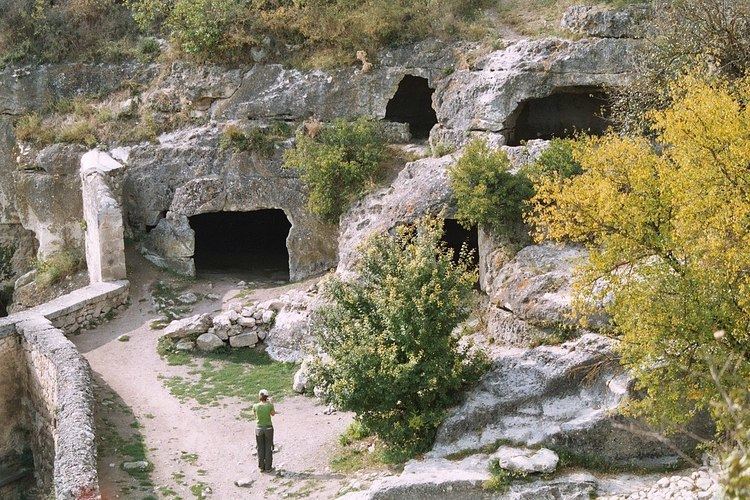Country Russia/Ukraine Time zone MSK (UTC+4) Local time Tuesday 1:26 AM | Established 6th - 10th century | |
 | ||
Weather 6°C, Wind SE at 8 km/h, 54% Humidity Similar Muzey «Larishes», Bakhchisaray Cave Monastery, Bakhchisaray Palace | ||
Chufut kale crimea ukraina
Chufut-Kale ([tʃuˈfut qaˈle]; Russian and Ukrainian: Чуфут-Кале - Chufut-Kale; Crimean Tatar: Çufut Qale; Karaim: Къале - Qale) is a medieval city-fortress in the Crimean Mountains that now lies in ruins. It is a national monument of Crimean Karaites culture just 3 km (1.9 mi) east of Bakhchisaray.
Contents
Its name is Crimean Tatar and Turkish for "Jewish Fortress" (çufut/çıfıt - Jew, qale/kale - fortress), while Crimean Karaites refer to it simply as "Fortress", considering the place as historical center for the Crimean Karaite community. In the Middle Ages the fortress was known as Qırq Yer (Place of Forty) and as Karaites to which sect the greater part of its inhabitants belong, Sela' ha-Yehudim (The Rock of the Jews).
Name versions
History
Researchers are not unanimous as to the time of the town’s appearance. The town was probably a fortified settlement in the 5th or 6th century οn the periphery of the Byzantine Empire. Others are of the opinion that the fortified settlement appeared in the 10th-11th centuries. During the early period of the town’s history, it was mainly populated by Alans, the most powerful of a late Sarmatian tribes of Iranian descent. They began penetrating the Crimea from the 2nd century AD. Settling down in the mountainous Crimea, the Alans adopted Christianity. In written sources the cave town is mentioned in the 13th century under the name of Kyrk-Or (Forty Fortifications). This name lasted until the mid-17th century. In 1299 the Tatar horde of Emir Nogai raided the Crimean peninsula. Kyrk-Or was among the sacked towns. Having seized the town, the Tatars quartered their garrison in it. At the turn of the 15th century, Tatars settled Karaite craftsmen in front of the eastern line of fortifications and built a second defensive wall to protect their settlement, and thus a new part of the town appeared.
In the 15th century the first Crimean Khan, Hadji-Girei, realizing the fortress’ advantages, turned the old section of the town into his fortified residence. After the defeat of the Golden Horde, the Crimean Khanate became considerably stronger. The significance of Kyrk-Or as a stronghold declined, and the Crimean Khan, Menglis-Girei, moved his capital to Bakhchisarai. The old town remained a citadel of Bakhchisarai and a place of incarceration for aristocratic prisoners. In the mid-17th century Tatars left Kyrk-Or. Only Karaites and several Krymchak families remained living there due to anti-Jewish restrictions on stays in other towns of the Crimean Khanate. Tatars considered Karaites to be Jews, hence the town gradually acquired the name of Chufut-Kale, which in Turkic meant “Jewish fortress” with negative and scornful meaning.
After the Crimea’s conquest and its inclusion into the Russian empire, the fortress inhabitants were permitted to live anywhere in the Crimea. From that time on, Chufut-Kale was deserted. By the mid-19th century the town ceased to exist.
Legends
There are many legends concerning the place. According to one, it was called "Qırq Yer" because the khans Meñli Giray or Tokhtamysh, the founders of the city, brought with them forty Karaite families, and in their honor called it the "Place of Forty".
Another legend, fostered by the Karaites to show the antiquity of their sect, says that Karaites were brought there from Persia at the time of the first Exile. The early settlers of the city exercised great influence upon their neighbors, the Khazars. The ḥakam Abraham Firkovich, who was very skilful in falsifying epitaphs and manuscripts, pretended to have unearthed at the cemetery of Chufut-Kale tombstones dating from the year 6 of the common era, and to have discovered the tomb of Sangari, which is still shown by the Karaites. According to Harkavy, however, no epitaph earlier than 1203 can be seen at the cemetery of Chufut-Kale, called "Vale of Jehoshaphat"; and the tombs do not belong to Karaites, but to the old Rabbinite settlers called Krymchaks. Chufut-Kale, however, existed as early as the seventh century. Abu al-Fida mentions it under the name "Qırq Yer".
In fiction
"Chufutkale" is mentioned (and also transliterated as "Chew-Foot-Calais") in Vladimir Nabokov's 1968 masterpiece, "Ada", page 338. The novel uses the site for the death of a minor character, Percy de Prey, during an imaginary Second Crimean War in 1888.
